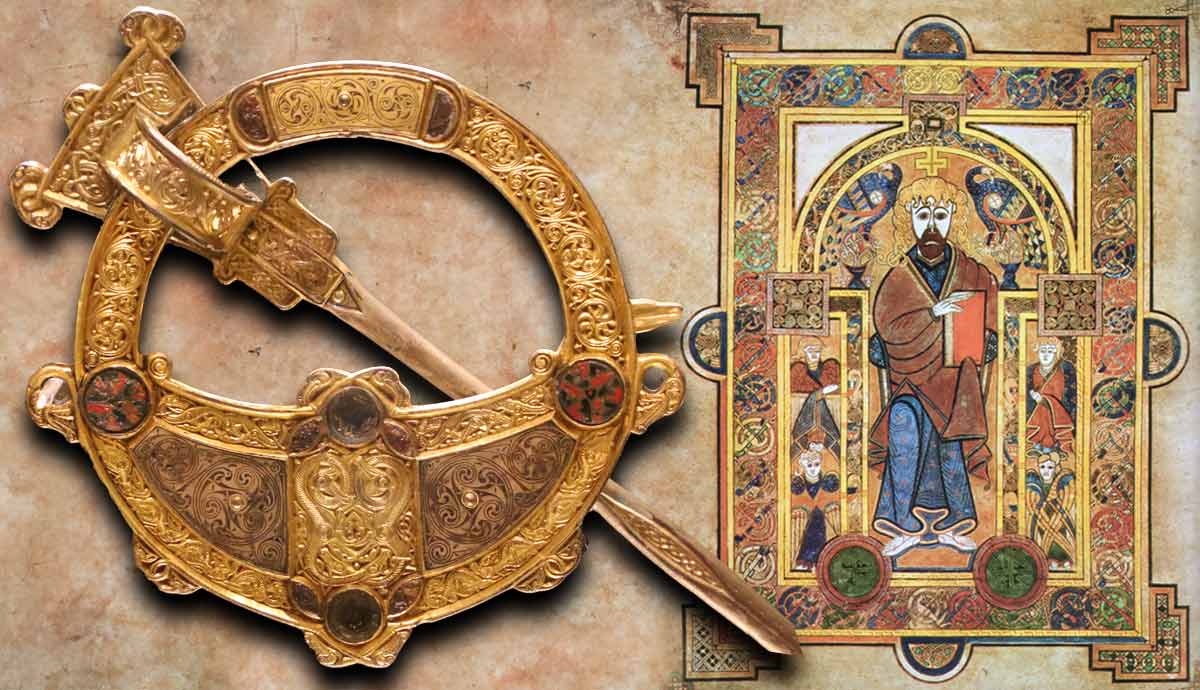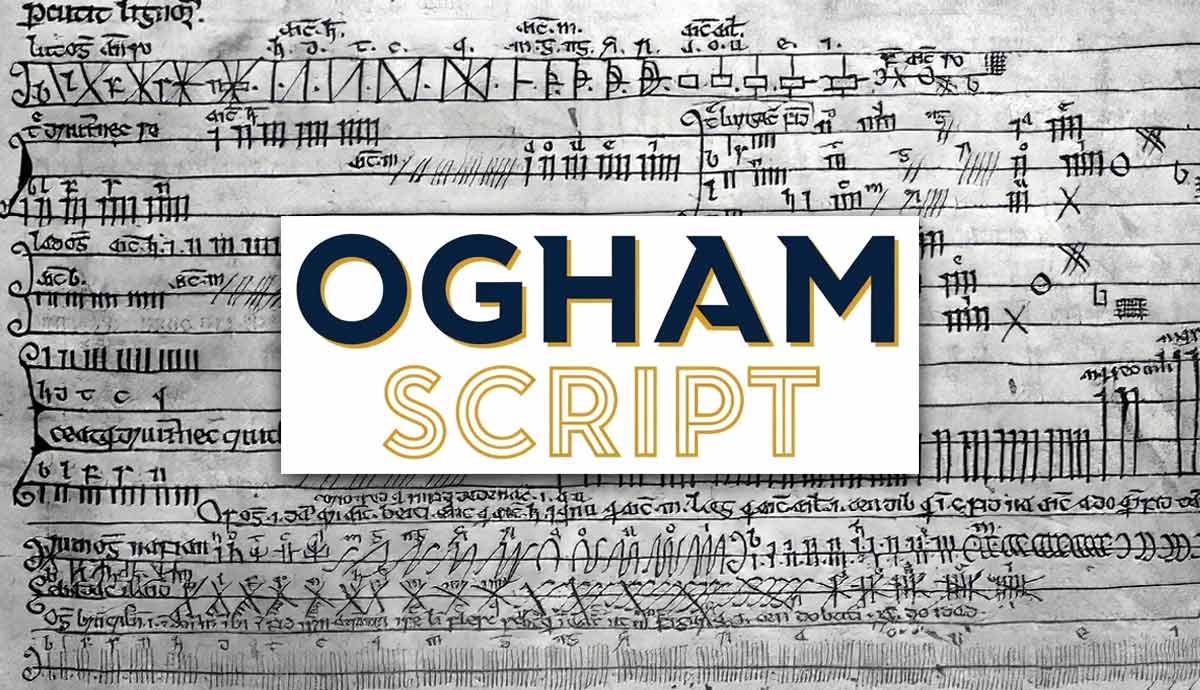
The Early Medieval Period in Ireland was defined by the development of the Celtic Christian church. Celtic Christianity is a form of Christianity that was common across the Celtic-speaking world during the Early Middle Ages. It was like the Latin Church in liturgical practice but it was also heavily influenced by pre-existing Celtic traditions in the area. The artwork that developed in Ireland during this period borrowed heavily from Celtic art styles as well, utilizing whorls and interlacing patterns that were initially popularized by pagan, Iron Age artisans. Some of the most well-known works of Early Medieval Irish art come from this visual tradition.
1. The Tara Brooch

The Tara Brooch, lauded as a national icon of Irish heritage, was rediscovered over 1,000 years after its original production and promptly became an object of fascination that spread across Ireland and the British Isles. Dated c. 710-750 CE, the brooch was rediscovered in Bettystown, Co. Meath in 1850 by either a woman or her child walking along the beach. The woman brought it to a local watchmaker who in turn sold it to the Dublin jeweler George Waterhouse.
Waterhouse gave the brooch the name “Tara,” likely to increase its value by referencing a recognizable Irish landmark: The Hill of Tara — which is about 40 kilometers from Bettystown. The Hill of Tara is mythologized as having been the seat of power for the ancient High Kings of Ireland. A necropolis and ritual site that was in continuous use from the Neolithic to the later Iron Age, its kings acquired symbolic status in the Early Middle Ages. So, could the Tara Brooch originally have been owned by a High King of Ireland?
The high degree of craftsmanship utilized to produce the Tara Brooch suggests that it absolutely could have been. The brooch is made from multiple precious metals, such as bronze, silver, and gold, and it is thought that the brooch was constructed from around fifty, individually crafted pieces. It is highly ornamented on both sides, featuring multi-colored enamel and glass studs, filigree, and niello-inlaid insular designs that take clear inspiration from the ancient, La Tène Celtic style. The brooch also features a glass-eyed, serpentine head at the base of its pin, characteristic of early medieval insular art.

Zoomorphic brooches like the Tara Brooch were status symbols for their wearers. This was a technique utilized by elite figures from the Roman Empire that the Irish kings had also adopted by the 7th century. These brooches were made to be seen. By adorning oneself with an object like the Tara Brooch, a king could indicate the depth of his wealth and power. Curiously the Tara Brooch is highly decorated on both sides, not just on the front, signifying that the actual wearing of the brooch could have been only ceremonial and that it was truly meant to be shown off by its owner and viewed in the round.
The Tara Brooch was one of many ancient and medieval objects that captivated the Irish public during the 19th-century Celtic Revival. However, George Waterhouse dubbing it the “Tara” Brooch was likely a marketing ploy. Waterhouse, alongside a few other Dublin-based jewelers, sold many reproductions of the Tara Brooch during the Celtic Revival. Reproductions of the brooch became status symbols for their wearers that not only signified wealth but also ties to an ancient, royal Irish past.
2. The Book of Kells

The Book of Kells is an illuminated manuscript, believed to have been made around the year 800, now housed at Trinity College in Dublin. Its origins are somewhat vague; it was created in a Columban monastery in either Ireland or Scotland. It is named after the Abbey of Kells in Co. Meath, Ireland, but some scholars believe that it was made on the Scottish island of Iona by monks of St. Columba’s order, and some others believe it was made in Northumbria.
A widely accepted theory is that monks began production on the manuscript at the Columban monastery in Iona and, after Viking raids on the island in the late 8th and early 9th century, the monks relocated to the Abbey of Kells, where the manuscript was finished. A Celtic Christian gospel book written in Latin, the manuscript contains the four gospels of the New Testament.

The Book of Kells is widely renowned as one of the most ornate illuminated manuscripts from the period. It is made of a range of illustrated pages, from non-figural carpet pages to depictions of Jesus Christ and the four Evangelists. The manuscript was written on vellum (pages made from animal skin) and it is believed to have been made by three anonymous scribes, known today only as Hand A, Hand B, and Hand C. The manuscript’s brilliant illuminations use many of the same La Tène Celtic-inspired designs as the Tara Brooch. It is believed that the Book of Kells was primarily a piece of artwork, with the text secondary to the images, as evidenced by several misspellings and other mistakes throughout the text. Much like the Tara Brooch, the Book of Kells was designed to be looked at more than it was designed for practical use.
3. The Ardagh Chalice

Thought of as one of the greatest treasures of the early Irish church, the Ardagh Chalice was originally discovered at the Ardagh Fort in Co. Limerick, Ireland and it was originally used for dispensing Eucharistic wine during the celebration of Mass. It was discovered in 1868 by two local boys as part of the Ardagh Hoard, which contained a cup and four brooches alongside the chalice, all from around the 8th-9th century. It is believed that the hoard was buried around the 1730s-40s, as it also contained a wooden cross from the Penal era in Ireland that was inscribed “727.”
The Ardagh Chalice is, in many ways, similar to the Tara Brooch in terms of production, style, and impact. The bowl and foot of the chalice are made of spun silver, while the exterior of the bowl is made of gold, silver, glass, amber, and enamel. It is decorated with ornate filigree and paneling and features similar insular, animal-style, La Tène Celtic designs. What is unique about the Ardagh Chalice, compared to the Tara Brooch and Book of Kells, is that it seems to be widely accepted that it would have been functional. Though clearly very beautiful, it may have been used somewhat regularly rather than strictly for ceremonies like the Tara Brooch, and it would have played a role in the celebration of Mass beyond existing for sheer beauty like the Book of Kells.

The Ardagh Chalice’s discovery in 1868 ensured its place as an object of public fascination during the Celtic Revival movement. Dublin-based jewelers like Edward Johnson created reproductions of it for purchase. Undoubtedly, the chalice’s reproductions would serve a less functional purpose than the original. These reproductions were not permitted to serve as vessels for consecrated wine, as they often were not wholly integrated into any kind of liturgical practice. Some reproductions, however, did end up in the collections of seminaries, for example. Reproductions of this nature may not have been used as vessels into which consecrated wine was poured, but they could be used to pour consecrated wine into another, blessed vessel.
4. St. Patrick’s Bell Shrine

St. Patrick’s Bell Shrine is a reliquary with two components: A bell and an exterior shrine. The bell is quite plain, made simply from iron lined with bronze, and dates to approximately 500 CE. The shrine is much more resplendent, made from bronze, silver, gold, glass, and rock crystal, and dates to several centuries later, c. 1094-1105. The panels on the shrine’s exterior possess a great level of detail in their ornate filigree, featuring swirling, serpentine patterns and motifs. The bell and the shrine are both significant to Irish history of their own accord; the bell is one of the oldest Irish objects with a continuous provenance, and the shrine is regarded as one of the most intricate treasures of Medieval Irish art.
The shrine was commissioned at some point after 1094 by the Uí Néill High King Domnall Ua Lochlainn and completed c. 1105 by the metalworker Cú Dúilig. The bell remained in the possession of the descendants of its keeper, Cathalan Ua Maelchallain, in Armagh until the end of the 19th century. The bell was a powerful relic, purportedly used by St. Patrick, and was used as a political tool after the shrine’s construction to legitimize Armagh as a place of religious significance. St. Patrick did establish his principal church in Armagh in the 5th century. The city remains an important religious site and place of cultural heritage.
5. The Lismore Crozier

The Lismore Crozier was discovered in a blocked doorway at Lismore Castle in 1814, and dates to between 1100 and 1113. It is made from a wooden staff lined with copper-alloy plates and embellished with silver, gold, niello, and glass. The crook itself is a single piece of bronze, hollow except for a small reliquary inserted in the drop. An inscription on the base of the crook confirms that it was built by a craftsman named Nechtain, and commissioned by Niall mac Meic Aeducain, bishop of Lismore. It was likely originally made for Lismore Abbey, which formerly occupied the site of the castle. The bishop died in 1113, offering a solid potential date range for the crozier commission.
The Lismore Crozier is both the only extant crozier to be inscribed and the only one whose date of origin can be closely approximated. The crozier’s design taps into stylistic influences like those used for the Tara Brooch and Bell Shrine, featuring swirling interlace and animals with open jaws and glass eyes. It is not completely intact, as it is missing some of its interlace filigree panels.
The crozier was likely produced as a symbol of religious power and authority. The Medieval Period in Ireland was a time of great political upheaval and religious reform — involving the Viking invasions, Norse settlement, and Anglo-Norman colonization — and many objects of religious significance, like the Lismore Crozier, were used to legitimize the monasteries from which they came as important religious centers. It is believed that the crozier was hidden during the later Medieval Period during a period of religious persecution and was likely forgotten when ownership of Lismore Castle shifted.
Bibliography
Koch, John T. (2006). Celtic Culture: A Historical Encyclopedia. ABC-CLIO.
Meyvaert, P. (1989). The Book of Kells and Iona. The Art Bulletin, 71(1), 6–19.
Murray, G. (2007). Insular-type crosiers: their construction and characteristics. In R. Moss (Ed.), Making and Meaning in Insular Art: Proceedings of the Fifth International Conference on Insular Art (79-94). Four Courts Press.
Whitfield, Niamh. (2001). The ‘Tara’ Brooch: An Irish Emblem of Status in its European Context. In C. Hourihane (Ed.), From Ireland Coming: Irish Art from the Early Christian to the Late Gothic Period and its European Context (pp. 211-247). Princeton University Press.









